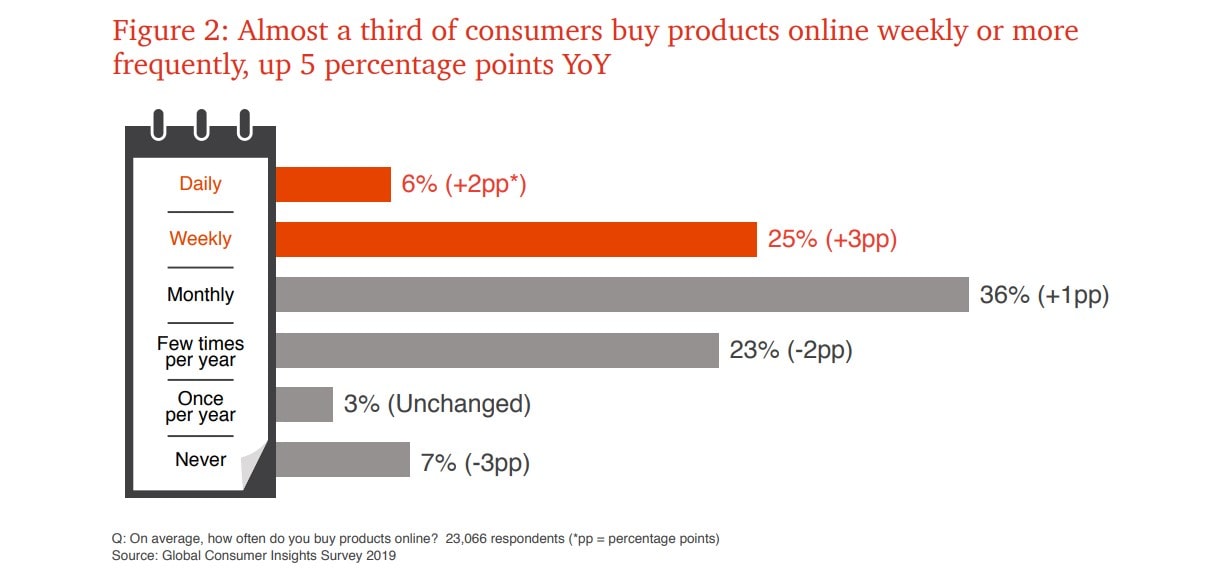What is a Customer Experience (CX) Marketer?
Table of contents
- Definition of a CX (customer experience) Marketer
- What does a CX Marketer do?
- CX Marketers make data-driven marketing decisions
What is a Customer Experience (CX) Marketer?
A Customer Experience Marketer is a new kind of marketer, part creative and part data scientist says John Cosley, Director, Global Brand and Digital Marketing at Microsoft/Bing.
Customer Experience is the result of every interaction (touchpoint) a customer has with your business, online and offline, at any stage in their buyer journey.
[bctt tweet=”A customer experience marketer is part creative and part data scientist #cxmarketer #customerexperience” username=”brand_minds”]
Why is customer experience vital to your business?
In this day and age, when digital has levelled the field for any business, customer experience is a competitive differentiator.
How a customer feels about your business is critical for customer growth, retention and advocacy. Long story short – your customer’s experience with your brand could potentially make or break your business.
HubSpot CEO Brian Halligan announced last year that his company replaced the traditional sales and marketing funnel with a new model, the Customer Flywheel. He believes the secret to building a great company is to provide a customer experience 10x lighter than the competition.
Positive customer experience can lead to turning your customers into brand ambassadors thus bringing in new customers & revenue which keeps the flywheel spinning.
Learn more: Goodbye, Marketing Funnel! Hello, Customer Flywheel!
In its 2019 Global Consumer Insights Survey, PricewaterhouseCoopers recommends brands and businesses to include another metric in addition to the traditional ROI – ROX or the Return on Experience. ROX is the metric with which marketers measure the purchase experience of their consumers.
Learn more: ROX is the new ROI
What is the job of the Customer Experience Marketer’s job? What does he/she do?
The customer experience marketer’s job is to create a better experience for the customer at every touchpoint, online or offline, no matter the stage they’re at in the buying journey.
Here are some of the points your customer is interacting with and for which the customer marketer is expected to create a positive experience:
- First contact – What is the customer’s first contact with our brand? How do we want the customer to feel while interacting with our brand for the first time?
- Social media – What does the customer see on our social media? How does our social content make them feel and think? Are these reactions exactly what we want to achieve as a brand?
- In-store – How do our customers feel like in our stores? What do they smell? It’s not a coincidence that the first thing customers smell when they come into any Lidl store is the amazing aroma of delicious pastry. This is a carefully designed customer experience!
- App/Website – Are our customers interacting easily with our app or website? What’s their experience with our digital platforms? Do they get what they want on our app/website with reduced friction and increased speed?
Data is key to unlocking smarter customer journeys.
John Cosley, Director, Global Brand and Digital Marketing at Microsoft/Bing
To create successful experiences that market to the customer journey, the CX marketer has to go through this 3-step process:
- Collect, unify, and analyze 1st-party data;
- Augment their first-party data and close the gaps with 3rd-party data;
- Understand the customer journey and create a holistic view of the customer based on insights provided by data.
CX Marketers make data-driven marketing decisions
In July of 2019, Microsoft Advertising conducted research with marketers and agencies to gather insights on how marketers use data to engage with customers.
The report is called Creating smarter customer journeys: A blueprint for the successful application of data and Artificial Intelligence in improving the customer experience.
It shows that successful CX marketers have adopted a data-driven approach which allowed them to:
- Have a better understanding of the customer decision journey (CDJ);
- Make more informed decisions based on that understanding;
- Improve customer engagement as a result;
- Improve marketing strategy as a whole.
Sources of 1st and 3rd party data according to the Microsoft Advertising report
The following sources provide 1st party data:
- Organic search data
- Site analytics
- Site visitor behaviour
- Customer-relationship management (CRM)
- Call centre data
- Ad serving data
Applications of 1st party data:
- Dynamic personalized creative
- Custom BI reporting
- Journey mapping
- CRM
- email/DR marketing
- Site personalization
The following sources provide 3rd party data:
- 3rd party data providers
- Location data companies
- Market research data (eMarketer, Gartner, Nielsen, HBR, Trendwatching etc)
- Targeting segments from ad partners
- DMP data marketplace (e.g. Oracle, Adobe)
Applications of 3rd party data:
- Customer/segment targeting
- Customer behavioural insights
- Multi-dimension campaign segmentation
- Campaign planning and forecasting
CX marketers who leverage the collected data, reach an in-depth understanding of their customers and their customer decision journey usually see a +45% incremental lift in ROI/ROAS for a typical campaign.
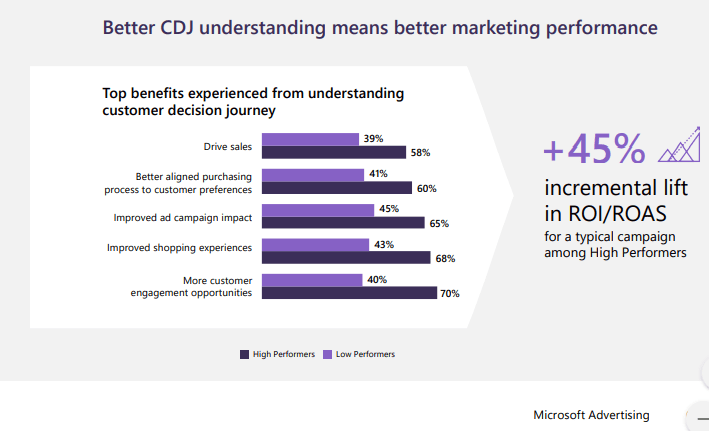
Source: Microsoft Advertising
Here are other results and benefits:
- More opportunities for customers to engage with brands
- Campaigns that better speak to customer needs
- Improved ad campaign impact
- Improved shopping experiences
- Better aligned purchasing processes to customer preferences
- Offers aligned to customer personas
- Personalized future customer decision journeys
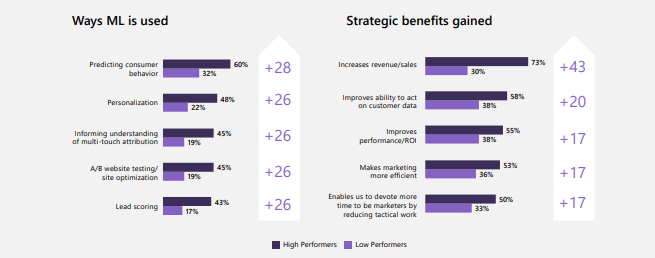
Source: Microsoft Advertising
Machine Learning (ML) is another great tool that CX Marketers can leverage to anticipate consumer behaviour and create smarter, more personalized advertising experiences.
Is a CX marketer part of your marketing team?
Join the Conversation
We’d love to hear what you have to say.
Get in touch with us on Facebook Group and Twitter.
Return On Experience (ROX) Is The New Return On Investment (ROI)
You may be familiar with Return on Investment as a metric but do you feel you need an additional performance measurement tool which illustrates more accurately the changes in our world with a direct impact on your business?
PwC offers you the answer to your question – Return on Experience.
What is ROI?
Return on Investment (ROI) is a performance measure used to evaluate the efficiency of an investment. To calculate ROI, the benefit (or return) of an investment is divided by the cost of the investment. The result is expressed as a percentage or a ratio.
ROI is a financial metric of profitability widely used in business. With the rise of digital and social media, business executives may find it difficult to calculate the ROI of their company’s marketing and advertising efforts on digital platforms.
What’s the ROI of social media?
Some digital experts believe that due to its human nature social media cannot be measured using a business-focused tool. Three years ago Gary Vaynerchuk famously replied to a business executive asking him repeatedly about the ROI of social media with What’s the ROI of your mother?
Other digital experts support the idea of looking at social media from a different standpoint – that of soft leads generator which I believe is more accurate. Marketers should find where social media fits best in their company’s funnels so that their efforts translate into results that can be measured.
Consumers have power over brands
Our world is changing; it’s not technology leading the change, it’s the people. It’s not the businesses running the show, it’s their consumers. They have power over brands, not the other way around.
According to PwC’s 2019 Global Consumer Insights Survey, it’s time to include another metric in addition to the traditional ROI. It’s the consumer-centred metric – the Return On Experience or ROX.
We need to introduce another metric, one with a laser focus on customer experience: return on experience. Whether your organisation is in the business of household goods, health services, selling cars or financial services, delivering a superior experience will be what makes you a winner.
PwC – 2019 Global Consumer Insights Survey
What is ROX?
The Return On Experience (ROX) is the metric with which marketers measure the purchase experience of their consumers.
Because consumers today are so discerning and powerful, it’s our perspective that most organisations need to invest far more in customer experience (CX). Measuring ‘return on experience’ (ROX), will help you understand your earnings on investments in the parts of your company directly related to how people interact with your brand.
John Maxwell, PwC’s Global Consumer Markets leader
Why should you include ROX in your measurement list?
Here are 10 of the report’s main findings which are good reasons for your company to include ROX as an additional measurement metric:
- 31% of consumers buy online weekly or daily;
- 24% of consumers shop on smartphones more often than on PCs – the first year in the decade PwC has been conducting this study that mobile phones were used more than other digital devices;
- 51% of respondents paid bills and invoices online;
- 51% transferred money online;
- 54% are streaming movies and TV 2x a week or more;
- 39% of Gen Z respondents said they go directly to social media for information compared with 25% overall;
- Mobile payment has been growing steadily since 2018, with China leading the way (86%) followed by Thailand (67%), Hong Kong (64%) and Vietnam (61%);
- 75% of consumers are using their mobile phones for health information;
- 46% of consumers would like to have an autonomous vehicle today or would consider one in the future;
- 35% of the survey’s respondents said they choose sustainable products to help protect the environment, 37% look for products with environmentally friendly packaging, and 41% avoid the use of plastic when they can.
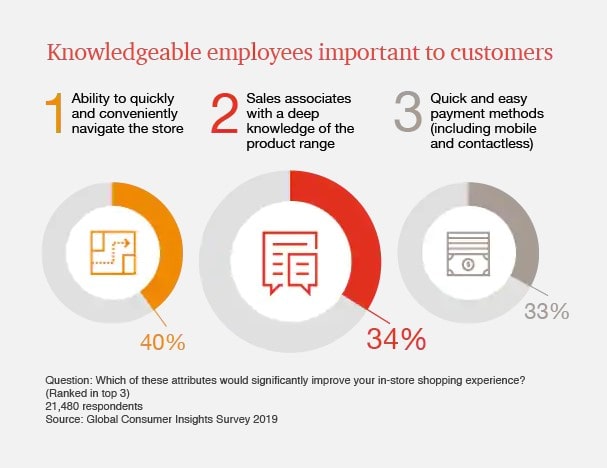

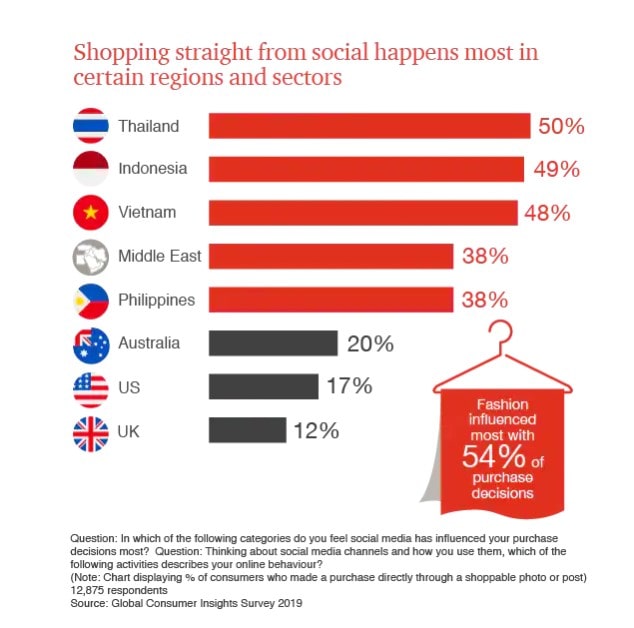
Now that you’re convinced of the power of your consumers and the importance of the customer experience, let’s see what factors contribute to great customer experience.
5 factors who drive great customer experience:
1. Less friction
Your company should aim towards a frictionless purchase journey. A purchase journey which eliminates friction as much as possible encourages your customers to buy more frequently and spend more money.
Amazon is a great example of a frictionless purchase journey.
2. Digital voice assistants
9% of consumers said they used voice technology to shop online weekly or more frequently. Using digital voice assistants makes it easier for consumers to buy. The voice technology contributes to the frictionless purchase experience.
Learn more: What Voice Search and AI Mean For Your Business
3. BOPUS
BOPUS is the acronym for buy online and pick up in store. BOPUS requires previous customer training but it works because it is convenient.
4. Blended experiences
A blended purchase experience means augmenting your customer’s in-person interaction with digital content before, during and after that interaction.
5. Employee experience (EX)
Last but not least, the employee experience is vital to creating excellent customer experiences. It means your company should invest in and improve the employee experience (EX) because EX has a big impact on customer experiences.
Learn more: Keeping Your Employees Happy Is More Than A Higher Paycheck
Are you looking to improve your ROX?
Based on the PwC survey results, here are 6 recommendations on how your company can improve its Return on Experience:
1. Fuse CX and EX
Companies that invest in and deliver superior experiences to both consumers and employees are able to charge a premium of as much as 16% for their products and services.
2. Build communities with a purpose;
3. Build on discreet moments along the customer journey;
4. Understand your customers based on their behaviours;
5. Treat consumers’ data with respect, and deliver value in exchange for it;
6. Win the trip.
Win over customers on-premise or via e-commerce by understanding what they are trying to experience and then making it easier for them to accomplish that goal.
Design your ROX-focused framework
What should your ROX-focused framework look like?
- Identify the things your company does exceptionally well;
- Make sure your IT systems, data infrastructure, business processes and performance metrics are aligned with those core capabilities;
- Identify your company’s ‘critical few’ behaviours; these behaviours are the ones that are most important to creating and delivering excellent customer and employee experiences;
- Quantify your progress in building these behaviours across functions, business units and geographies;
- Use your metrics to gain deeper insights into what matters most to customers;
- Quantify what’s most important along the path to purchase and what factors are most influential in driving customer behaviours.
Join the Conversation
We’d love to hear what you have to say.
Get in touch with us on Facebook Group and Twitter.
The customer experience in B2B marketing
A research by SiriusDecisions found that for 80% of B2B buyers surveyed, customer experience counted as the top significant reason why they chose to work with a specific provider over another. This 80/20 correlation is not a surprising revelation, meaning that customer experience is critical for customer growth, retention and advocacy and could potentially make or a break a company’s success.
The bad news is that most B2B companies are failing to meet post-sale customer experience expectations. 45% of the B2B customers that SiriusDecisions talked to indicated that they aren’t getting the value they were promised. As a result, 42% indicated that they’re not sure about renewing with their vendor, while 61 % aren’t willing to recommend their providers. The study also shows a widening gap in terms of how executives and customers perceive the post-sale experience.
According to EY, it’s important to see that business-to-business (B2B) buyers are increasingly behaving like consumers — taking advantage of self-service digital channels to shape how they learn about and purchase products. This “consumerization” of B2B buying has made
customers increasingly elusive. To remain relevant, sales professionals can no longer carry on as they used to, they need to become just as digital as
their customers.
In this context, B2B marketers need to think about the end-to-end experience of customers. Companies need to pay particular attention to the post-sale experience—to make sure that they understand the wants, needs and pain points of the customers they serve.

Some of the main ideas we want to pinpoint for you from the EY study:
B2B buyers also have become more empowered. The advent of more transparent marketplaces and the proliferation of online content and digital communities, combined with social media, allow buyers to increasingly self-educate when evaluating their product and service options — and to make many of their purchases directly without ever dealing with a salesperson.
According to International Data Corporation (IDC), 50%—80% of
buyers’ decision-making processes are complete before a salesperson gets involved and 90% of decision makers say they never respond to cold outreach. In other words, B2B buying behavior is starting to look a lot more like that of B2C.
Buyers’ values and perspectives also are evolving as younger generations become a larger and more influential portion of the workforce.
It gets much more difficult for B2B companies to get customers’ attention and build relationships with them and create and sustain brand loyalty.
The important thing is to work out how we can get the same experience regardless of where customers interact with the companies and provide richer and richer experiences that add a lot of value as they go through the journey with us.
Identify leads and the right decision makers more effectively with social networking.
It’s important to put emphasize on leadership. According to a 2017 Edelman-LinkedIn report, 9 in 10 business decision-makers find thought leadership
important or critical to their decision process, while 82% said that thought leadership increased their trust in a vendor organization.
While B2B companies have made progress toward omni-channel sales, they still have a long way to go. According to one study, three-quarters of participating
B2B companies generated no more than 20% of their sales via e-commerce. Yet that’s likely to change in the near future, as a majority of respondents in that study expected their e-commerce sales to rise by over 5% in the next
12 months. (source: Interview conducted specifically for this whitepaper with Phil Lurie, SAP’s Vice President of Sales Technology.)
By shifting to a digital selling model, supported by a robust center of excellence, B2B companies can develop the tools, technologies and processes they need to create and develop stronger relationships with and relevance to customers in an
evolving digital world.
Moreover, according to a BCG research, here’s a new generation of B2B customers out there who do not expect, and in many cases do not want, to deal with a salesperson until it’s time to close the deal.
These new buyers look for the same digital experiences and features—including on their smartphones—that they encounter as consumers. Decision makers are increasingly supported by young, tech-savvy researchers, who commonly use mobile for work and multitask on more than one screen.
How relevant is still TV for your brand?
We are smarter and smarter consumers, more up-to-date with everything that is new and happening in the world of technology, people constantly changing and improving their laptops, mobile phones and software that they are using. Moreover, 2017 proves to be the first year that the media investments in digital are surpassing the TV ones. In this context, it’s only natural for a CEO or a marketing specialist to wonder how relevant is still TV for the brand they are taking care of?

In other words is video killing the radio star? Or is it a non-subject that the specialists are over-exaggerating talking about? What do you think? Well, this is what we think.
First of all we believe that there is not a general answer of yes or no. The right answer for your brand will come from your target: who are they, what are their consumption preferences, their passions, hobbies, desires, etc. Better knowing your target will give you the right answer. Because if you are looking at the younger generation the answer is pretty easy, but if you are targeting the Millennials or the older generation you will have for sure another look at the situation and things will not seem that much black and white.
Along with the channels and devices available for watching TV, the ways for brands to reach consumers through the medium are proliferating. Quoted by Marketing Week, Otto Rosenberger, CMO at Hostelworld.com, believes that TV buying is changing, and with good reason. He says: “It really always starts with being obsessed about where the customer is. It’s about where they are and what drives them, which drives our creative and media decisions.” Research released by Ofcom earlier this month shows that while live television remains hugely important, catch-up TV viewed via the internet and programming premiered online are taking up an increasing share of viewing time for younger audiences in particular. It reveals that today, only 50% of 16- to 24-year-olds’ TV consumption is through live television, rising to 61% for 25-to 34-year-olds.
“The overarching shift, therefore, is in the power of technology and the internet. It is not only changing the way people watch TV, it is also creating a significant change in the way TV advertising is being traded towards targeting specific segments of audiences known to be watching rather than programmes that research panel data suggests they might see,” explains Marketing Week.
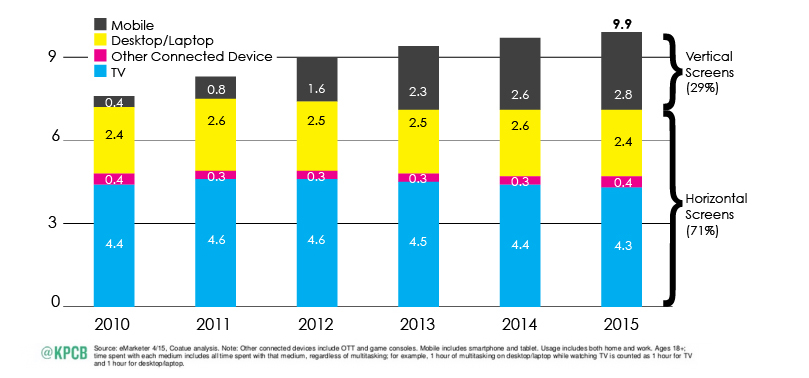
Not a long time ago, Turner Broadcasting and Horizon Media partnered on with marketing-analytics company MarketShare, which meta-analyzed thousands of marketing optimizations used by major advertisers from 2009 to 2014. MarketShare’s analysis found that TV advertising effectiveness has remained steady during that time period and outperforms digital and offline channels at driving key performance metrics like sales and new accounts. The study also showed that networks’ premium digital video delivered higher than average returns when compared with short-form video content from non-premium publishers. More on the main results you can read here.
Moreover, we need to think about the fact that a deep investigation of the decision journey often reveals the need for a plan that will make the customer’s experience coherent—and may extend the boundaries of the brand itself. The details of a customer experience plan will vary according to the company’s products, target segments, campaign strategy, and media mix. But when the plan is well executed, consumers’ perception of the brand will include everything from discussions in social media to the in-store shopping experience to continued interactions with the company and the retailer.
“Consumers’ perception of a brand during the decision journey has always been important, but the phenomenal reach, speed, and interactivity of digital touch points makes close attention to the brand experience essential—and requires an executive-level steward. At many start-ups the founder brings to this role the needed vision and the power to enforce it. Established enterprises should have a steward as well. Now is the time for CMOs to seize this opportunity to take on a leadership role, establishing a stronger position in the executive suite and making consumers’ brand experience central to enterprise strategy,” said David C. Edelman for Harvard Business Review.

A study done by Arris showed that 84% of respondents wanted to fast forward through the ads they watch, while 60% of them download or record shows so they can skip commercials. Even Super Bowl ads have lost their effectiveness: a 2014 study showed that 80% of them do not increase sales for the companies running them. The increased use of smartphones and tablets also detracts from TV commercials’ relevance. A study in May 2015, quoted by The Guardian, showed that researchers found that viewers who focused just on the TV screen were able to recall 2.43 out of every three brands mentioned, while smartphone and tablet users only managed to recall 1.62 on average.
Moreover, advertising’s even losing its role as an information source: a study by Mindshare earlier in 2015 showed that the percentage of Americans who said advertising helped them learn about products and services dropped from 52% in 2005 to 41% in 2014.
Still, all in all, TV is still relevant and will still be as long as the brands will know how to adapt to the new changes it brings and will know how to showcase its added value. As long as the TV advertising will continue to adapt and become better and more relevant for its audience, it will of course remain very important.
On how brands can optimize their TVCs to drive product discovery, you can read here.
The greatest mistakes a brand can make online
Waiting too long to launch a product / service.
Like in a relationship, so it happens in business: the perfect timing is essential. In the desire to be sure everything is perfect, most entrepreneurs or business owners wait too long, therefore missing the right opportunity to launch the business, the service or the product. It’s important not to forget to trust your guts and just go for it.
“Some people are waiting for some magic audience size “1,000 subscribers” or maybe “10,000 visitors” or whatever your number might be. Some people just can’t find the time to blog or podcast or make videos AND to build a product at the same time. It’s tough. Some people simply talk themselves out of creating a product because they’re afraid no one will buy it. They don’t want to fail after putting in so much time creating content. Whatever the reason, this is a fatal trap. If you’re building a business, you need to address the biggest risk head-on. The biggest risk you’ll face as a business is in creating something no one will pay for,” wrote Corbett Barr for fizzle.co.
Not checking and double checking before posting
Still, one must be very careful before sending the message into the world. Each post on social media should be treated with a lot of attention and care, otherwise it may do more harm than good. Often we see big grammar mistakes, pictures that are not doing any favor to the brand, wrong comments or even worse. Even they are taken down afterwards, it might be too late.
Fabricating pieces of news or information
For each brand the trust must be earned. People don’t like to be lied to or be mislead, therefore you must make sure that every piece of information you share with your target is 100 % true. Today, every piece of content is very easily checked by anyone. If you do make a mistake, make sure to apologize for it. Everybody can make mistakes, the important thing is to own it and act accordingly. Your target will understand and respect you. Don’t hide and act like nothing happened or erase the post.
The lack of patience.
Brands are not built overnight. Building an online brand takes patience. It’s something that’s built brick by brick with every tweet, every blog post, and every podcast episode. It’s built with every client one step at a time. One of the biggest mistakes business owners do is thinking that a brand can be build in only 2-3 months online and complaining after this short period of time that they aren’t seeing any traction. In reality, building a brand takes years of hard work, experience, people and investment, so make sure you think of all those aspects prior to starting on this road.
Not being consistent.
You can’t build an online brand without consistently putting a message out there. A social media following is gained in time, after a lot of work on strategy and implementation, an e-commerce business takes months of work prior to launch and after launch, until the first signs of success occur. Time and dedicated teams that are working towards the same purpose, following a strategy based on true insights. Constant content must be sent on regular basis to all the social media platforms of your brand, PR, marketing & sales efforts are also needed. Constant, insightful, creative and powerful messages, perfectly targeted to your interest group or groups. “If you’re having difficulty being consistent with your content creation as you build an online brand, try automating your social media needs and creating an editorial calendar for your site. The more organized you can be the better,” said Amanda Abella, writer and author of “Make Money Your Honey”.
Not putting customer experience first
Customer experience is one of the most important factors in your business, especially today in the world on the Internet and social media frenzy. Since your social interactions are public for everyone to see, your reactivity defines your brand and shows customers how much you care. The more you interact with them and show them your interest in them, the better. Don’t be shy on giving special discounts or mentions on your social media accounts to the people that are loyal to you and choose your brand on a regular basis.
Not really listening to their consumers
And believing that you and your team always know better. It;s important not to forget that from the unhappy consumers or the ones that choose not to buy your product / service in favor of another one, you can learn the most. They are the unbiased ones and their opinion should be treasured. Don’t just pay lip service to your customers. You don’t have all the answers, they do. There’s a reason why “the customer is always right,” because without customers you don’t have a business.
Focusing mostly on acquisition
It takes a lot more effort to attract a new customer than to keep an existing one, so you may want to keep your customers happy. Offer help, give away freebies, or conduct regular surveys to make sure their needs are met.
Here are some of the biggest mistakes in social media, according to Forbes.


